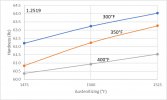- Joined
- Nov 9, 2019
- Messages
- 13
I make lot of knife from 1.2519 steel .Crazy sharp and can take very , very thin edge .........63-64 Hrc
That's good to know, seems like this could be a good option for me and it is reasonably priced so I won't be quite so sad when I make mistakes. After making several like this I'll be after a tough steel for my next projects





